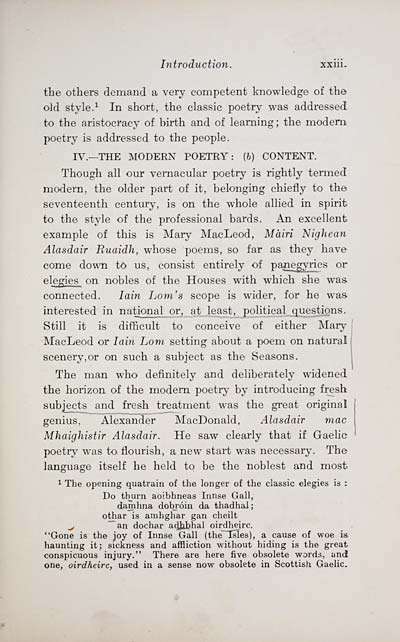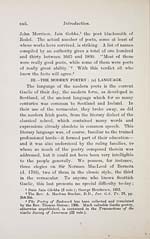Download files
Complete book:
Individual page:
Thumbnail gallery: Grid view | List view

Introduction. xxiii.
the others demand a very competent knowledge of the
old style.^ In short, the classic poetry was addressed
to the aristocracy of birth and of leaming; the modem
poetry is addressed to the people.
IV.— THE MODERN POETRY : (6) CONTENT.
Though all our vemacular poetry is rightly tenned
modern, the older part of it, belonging chiefly to the
seventeenth century, is on the whole alHed in spirit
to the style of the professional bards. An excellent
example of this is Mary MacLeod, Màiri Nighean
Alasdair Ruaidh, whose poems, so far as they have
come down tò us, consist entirely of paae^rics or
e legies on nobles of the Houses with which she was-
connected. lain Loni's scope is wider, for he was
interested in na tional or, at least, politieal questions.
StiU it is difficult to conceive of either Mary
MacLeod or lain Lom setting about a poem on natural
scenery,or on such a subject as the Seasons. |
The man who defìnitely and dehberately widened
the horizon of the modem poetry by introducing fr^sh
subjectsand fresh treatment was the great original
genius, Alexander MacDonald, Alasdair mac
Mhaighistir Alasdair. He saw clearly that if GaeHc
poetry was to flourish, a new start was necessary. The
language itself he held to be the noblest and most
1 The opening quatrain of the longer of the classic elegies is :
Do thurn aoibhneas Innse Gall,
damhna dobi'òin da thadhal ;
othar is amhghar gan cheilt
^ an dochar adilbhal oirdheirc.
"Gone is the joy of Innse Gall (the Tsles), a cause of woe i»
haunting it; sickness and affliction without hiding is the great
conspicuous injury." There are here five obsolete words, und
one, oirdheirc, used in a sense now obsolete in Scottish Gaelic.
the others demand a very competent knowledge of the
old style.^ In short, the classic poetry was addressed
to the aristocracy of birth and of leaming; the modem
poetry is addressed to the people.
IV.— THE MODERN POETRY : (6) CONTENT.
Though all our vemacular poetry is rightly tenned
modern, the older part of it, belonging chiefly to the
seventeenth century, is on the whole alHed in spirit
to the style of the professional bards. An excellent
example of this is Mary MacLeod, Màiri Nighean
Alasdair Ruaidh, whose poems, so far as they have
come down tò us, consist entirely of paae^rics or
e legies on nobles of the Houses with which she was-
connected. lain Loni's scope is wider, for he was
interested in na tional or, at least, politieal questions.
StiU it is difficult to conceive of either Mary
MacLeod or lain Lom setting about a poem on natural
scenery,or on such a subject as the Seasons. |
The man who defìnitely and dehberately widened
the horizon of the modem poetry by introducing fr^sh
subjectsand fresh treatment was the great original
genius, Alexander MacDonald, Alasdair mac
Mhaighistir Alasdair. He saw clearly that if GaeHc
poetry was to flourish, a new start was necessary. The
language itself he held to be the noblest and most
1 The opening quatrain of the longer of the classic elegies is :
Do thurn aoibhneas Innse Gall,
damhna dobi'òin da thadhal ;
othar is amhghar gan cheilt
^ an dochar adilbhal oirdheirc.
"Gone is the joy of Innse Gall (the Tsles), a cause of woe i»
haunting it; sickness and affliction without hiding is the great
conspicuous injury." There are here five obsolete words, und
one, oirdheirc, used in a sense now obsolete in Scottish Gaelic.
Set display mode to: Large image | Transcription
Images and transcriptions on this page, including medium image downloads, may be used under the Creative Commons Attribution 4.0 International Licence unless otherwise stated. ![]()
| Early Gaelic Book Collections > Matheson Collection > Bardachd Ghaidhlig > (27) |
|---|
| Permanent URL | https://digital.nls.uk/76422858 |
|---|
| Description | Specimens of Gaelic poetry 1550-1900. |
|---|---|
| Shelfmark | Mat.50 |
| Additional NLS resources: | |
| Attribution and copyright: |
|
| Description | Items from a collection of 170 volumes relating to Gaelic matters. Mainly philological works in the Celtic and some non-Celtic languages. Some books extensively annotated by Angus Matheson, the first Professor of Celtic at Glasgow University. |
|---|
| Description | Selected items from five 'Special and Named Printed Collections'. Includes books in Gaelic and other Celtic languages, works about the Gaels, their languages, literature, culture and history. |
|---|

